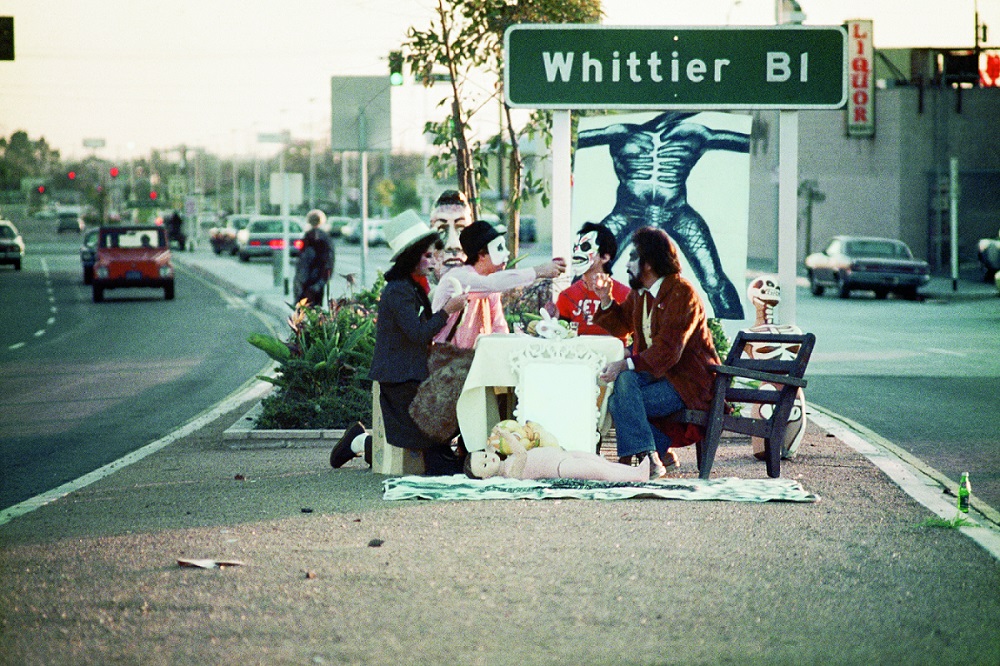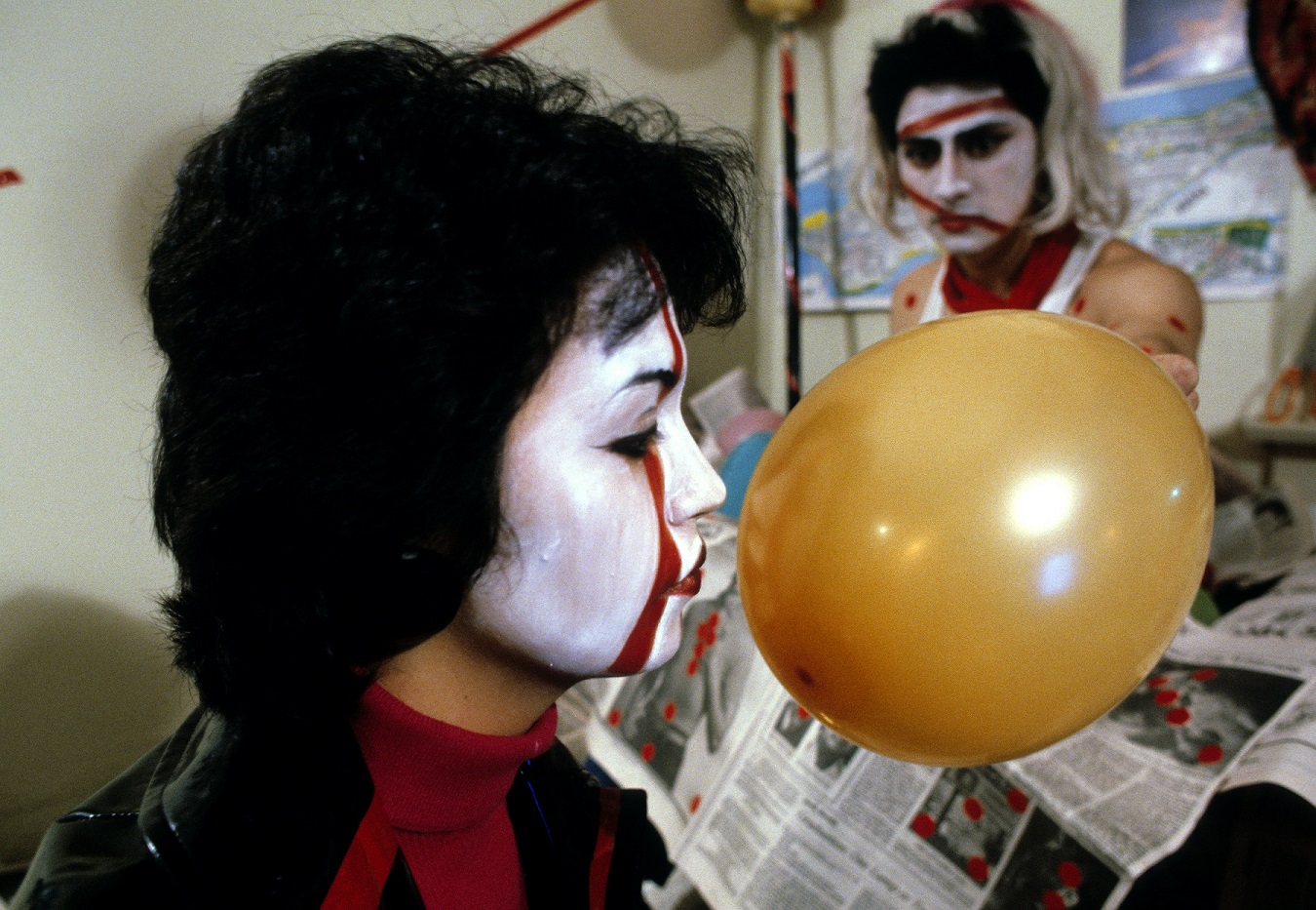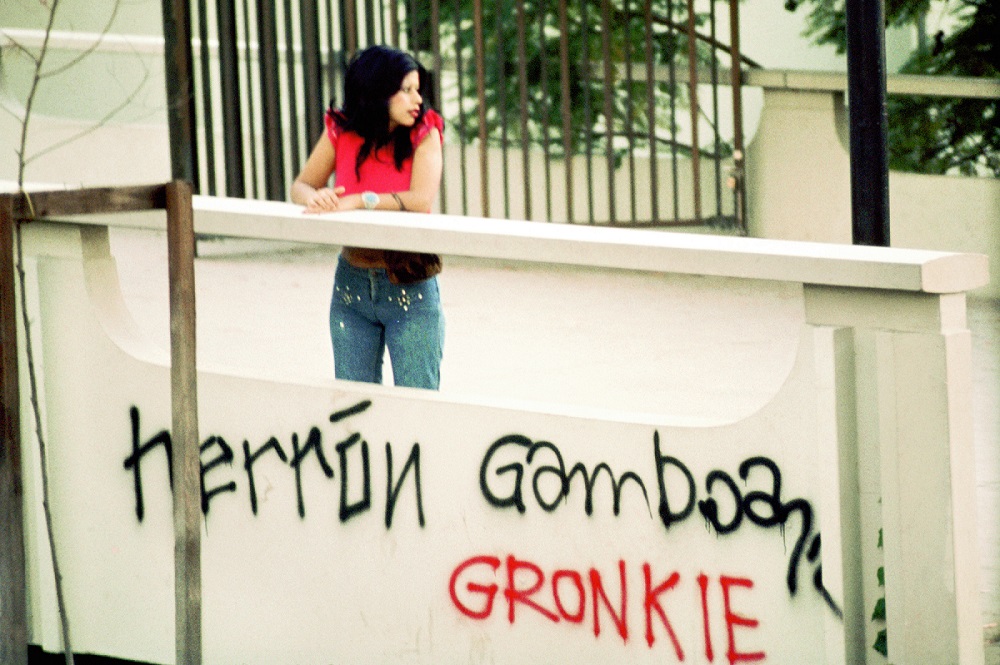Edición 10.5: ALAC Reader "Soñadores" - Borderlands California Los Angeles USA
Tiempo de lectura: 5 minutos

09.01.2018
Asco’s ephemeral actions reconfigured the patterns of public space.

Stations of the Cross (1971) was the East Los Angeles collective’s first public spectacle: a walking mural along a one-mile stretch of Whittier Boulevard in East Los Angeles, performed on Christmas Eve. It was also Asco’s earliest attempt at reclaiming the streets. The act served as a theatrical, public protest against the Vietnam War. The four main members of the collective—Harry Gamboa Jr., Gronk, Willie Herrón III, and Patssi Valdez—formed the carnivalesque work.[1] Herrón led the procession dressed as a colorful combination of a Christlike figure and a skeleton; the muralist Gronk, dressed in a Pontius Pilate costume, blessed the procession with a box of popcorn; Gamboa held up a cardboard-constructed image of a cross; his painted face poked through a dead altar boy costume. As the collective transformed the traditional Mexican Las Posadas[2] ritual, the work served to disturb the Chicanos enlisting for the army on that day. In a repeat performance the next day, Patssi Valdez joined the rest of the members, outfitted in a homemade, glamorized Day of the Dead costume. The performances were witnessed only by a few friends and unknowing passersby.
Throughout Asco’s run, from 1971–87, the collective fluctuated between twenty and thirty members. Their main medium was the counterspectacle. They enacted the emancipatory potential of physical space in Los Angeles, and of aesthetic imagination—both of the artists and the spectator. Asco’s works decolonized conceptual and high art by reframing Mexican traditions, and remixing street culture, gang culture and homemade Pacheco fashion designs. They used a variety of tactics such as guerilla street theater, hit-and-run interventions, performances, graffiti, and image stills. Documentation served as an important tool for Asco, which is the Spanish word for disgust, as in ‘me da asco’ or ‘it [your art] disgusts me,’ derived from an exhibition the artists organized called asco-zilla, in which the collective humorously exhibited bad works of art that would otherwise not be seen.
Chicano scholar Chon A. Noriega writes, “By naming themselves Asco, the artists refuse the notion that their work falls outside the norms or boundaries of the Mexican descent community in East Los Angeles. Instead, they reinsert their art within the cultural logic of the community itself…”[3] From the start, Asco wanted their productions to serve as a counternarrative to the “Mural Movement and the Chicano Art Movement [which] had become the ‘frozen revolution’ of Mexico…”[4] For their work Instant Mural (1974), the muralist Gronk reappropriated a blank wall outside of a liquor store in East Los Angeles and used masking tape to attach Asco’s Patssi Valdez and Humberto Sandoval to the wall. In photo documentation, a glamorized Patssi stands in profile, dressed in high platforms, short jean shorts, and a bright red jacket. Playfully ridiculing the muralist tradition’s penchant for large-scale heroism and glamorization of labor, Asco challenged what a Chicano mural could look like, move like, and furthermore, the way public space could house a more accurate, or irreverent representation of a community in flux.

Using streets known to their communities for police brutality and surveillance, Asco viewed the walking mural as a humorous act whose theatrics did not detract from their activist agenda. As Gamboa states, “We were trying to reflect the violence around us…and we were breaking people’s preconception of what Chicano artists should do.”[5] From the beginning, Asco recognized space as both a conceptual and activist terrain in which the work could serve as politics.
In the 1974 work First Supper (After a Major Riot), the artists staged a Christmas Eve dinner party on a busy traffic island on Arizona Street and Whittier Boulevard. This particular island had been built over a bloody site of the East LA riots; a 1973 urban development process had leveled the areas around the island to prevent further demonstrations. The four artists put on a carnival-inspired spectacle in the middle of this location, seated in mismatched chairs at a white linen-covered table, adorned with painted faces, masks, top hats, and as Gamboa recalls, “a large nude doll, paintings of tortured corpses, mirrors, chairs, food, drink, and riotous guests.”[6]
As art historian Rosalyn Deutsche writes, “Public space is the limit of tutelary power. It is the space where people declare rights and which, paradoxically, is constituted through declaration. A fixed point of access to politics, a unique space of the political, and the essence of social reality…”[7] In short, space is not neutral: it is the result of political struggle, just as it is the site where political struggle takes place. First Supper (After a Major Riot) was a performative gesture that established a temporary political space—one that acknowledged those systems of exclusion and erasure which sought to snuff out a community’s memory as much as its members. Though no spectators joined the dinner party—many honked their horns—[8]it was nonetheless an invitation.
As philosopher Henri Lefebvre has remarked, “Inasmuch as abstract space [of modernism and capital] tends towards homogeneity, towards the elimination of existing differences or peculiarities, a new space cannot be born (produced) until it accentuates differences.”[9] Through mobile, performative interventions such as Stations of the Cross and First Supper (After a Major Riot), Asco called into question the neutrality of both public space and the space of art institutions. Challenging the “authenticity” of Chicano representations and their “frozen” codification within art, Asco privileged their immediate community as their audience and expanded the way Chicano history and identity could be understood from within and without. Asco’s ephemeral actions interrupted and reconfigured the normal pattern of public space, attending to erased histories, contestations, and ongoing struggles. With the streets of Los Angeles as both the set for their work and its subject, the artists used their bodies and the public to work out new definitions for an avant-garde.

The four main members of Asco met in the politically charged environment of Garfield High School in East Los Angeles. Harry Gamboa Jr. was a major organizer of the school protests against the racist school policies and inadequate education, known as the “blowouts.” Soon after, a fueled Gamboa formed the art and literary journal Regeneración and invited the others to collaborate.
Las Posadas is a nine-day Mexican festival that reenacts the Bible story of Joseph’s search for shelter. It is celebrated mainly in Mexico and Guatemala. The procession begins December 16th and ends December 24th.
Chon A. Noriega, “Your Art Disgusts Me: Early Asco: 1971-75,” Afterall 9 (2008): 74.
C. Ondine Chavoya, “Internal Exiles: The Interventionist Public and Performance Art of Asco,” Space, Site, Intervention: Situating Installation Art, ed. Suderburg, Erika (Minnesota: U of Minnesota P, 2000), 194.
Rita Gonzalez, “Phantom Sites: the Official, the Unofficial, and the Orificial,” Phantom Sightings: Art After the Chicano Movement, ed. Rita Gonzalez, Howard N. Fox, Chon A. Noriega (Los Angeles: U of California P, 2008) 48.
Harry Gamboa Jr., Urban Exile: Collected Writings of Harry Gamboa Jr., ed. Chon A. Noriega (Minnesota: U of Minnesota P, 1998) 80.
Rosalyn Deutsche, “Art and Public Space: Questions of Democracy,” Social Text 39 (1992): 51.
As Gamboa recalls, “The immediate reaction of the audience was primarily confusion laced with verbal hostility.”
Henri Lefebvre, “Plan of the Present Work” trans. Donald Nicholson-Smith, The Production of Space, (Cambridge, MA: Blackwell, 1991): 52.
Comentarios
No hay comentarios disponibles.